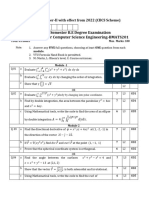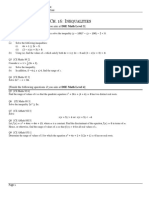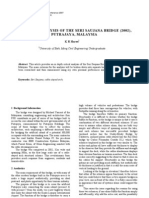Upes 2022 Question Paper
Upes 2022 Question Paper
Uploaded by
Ved PrajapatiCopyright:
Available Formats
Upes 2022 Question Paper
Upes 2022 Question Paper
Uploaded by
Ved PrajapatiOriginal Description:
Original Title
Copyright
Available Formats
Share this document
Did you find this document useful?
Is this content inappropriate?
Copyright:
Available Formats
Upes 2022 Question Paper
Upes 2022 Question Paper
Uploaded by
Ved PrajapatiCopyright:
Available Formats
Name:
Enrolment No:
UNIVERSITY OF PETROLEUM AND ENERGY STUDIES
End Semester Examination, May 2022
Course: Mathematics II Semester: II
Program: B.Tech. (Non-CIT) Time: 03 hrs.
Course Code: MATH 1027 Max. Marks: 100
Instructions:
Attempt all questions from Section A (each carrying 4 marks); attempt all questions from Section B
(Each carrying 10 marks) and attempt all questions from Section C (each carrying 20 marks). Question
8 and 11 have internal choice.
SECTION A
S. No. Marks CO
If 𝑥 ℎ 𝑦 𝑘 is an integrating factor of the non-exact differential equation
Q1 (2𝑥 2 𝑦 2 + 𝑦)𝑑𝑥 − (𝑥 3 𝑦 − 3𝑥)𝑑𝑦 = 0, 4 CO1
then find ℎ and 𝑘.
Find the solution of the differential equation
Q2 𝑑2 𝑦 𝑑𝑦 4 CO1
2𝑥 2 𝑑𝑥 2 + 𝑥 𝑑𝑥 − 6𝑦 = 0 (𝑥 > 0).
Determine for what value(s) of integer 𝑛 the function 𝑢(𝑥, 𝑦) = 𝑥 𝑛 − 𝑦 𝑛 is
Q3 4 CO2
harmonic?
1
Q4 Identify the type of singularity of the function 𝑓(𝑧) = 𝑒 ⁄𝑧 at 𝑧 = 0. 4 CO3
Q5 Classify the partial differential equation 𝑥 2 𝑢𝑡𝑡 − 𝑢𝑥𝑥 + 𝑢 = 0. 4 CO4
SECTION B
Find the general solution of the differential equation
Q6 𝑑2 𝑦 𝑑𝑦 10 CO1
+ 4 𝑑𝑥 + 3𝑦 = 7𝑥 − log 𝑒 3.
𝑑𝑥 2
sin6 𝑧
Using Cauchy’s integral formula, evaluate ∫𝐶 𝜋 3
𝑑𝑧, where 𝐶 is the circle
Q7 (𝑧− )
6
10 CO2
|𝑧| = 1.
𝑒 𝑧 −1
Apply Residue theorem to evaluate the integral ∫𝐶 𝑑𝑧 where 𝐶 is
𝑧(𝑧−1)(𝑧−𝑖)2
the circle |𝑧| = 2.
OR
Q8 Find Taylor’s and Laurent’s series expansion of the function 10 CO3
1
𝑓(𝑧) =
(𝑧 + 1)(𝑧 + 2)2
in the regions (i) |𝑧 − 1| < 2 (ii) |𝑧 − 1| > 3.
Form a partial differential equation by eliminating the arbitrary constants 𝑎, 𝑏, 𝑐
𝑥2 𝑦2 𝑧2
Q9 from 𝑎2 + 𝑏2 + 𝑐 2 = 1. 10 CO4
SECTION-C
(2Qx20M=40 Marks)
∞ 𝑥2
(i) Evaluate the real definite integral ∫−∞ (1+𝑥 2 )(4+𝑥 2 ) 𝑑𝑥 using contour
integration.
Q 10 (ii) Find the bilinear transformation which maps the points 𝑧 = 0, −𝑖, −1 into 10+10 CO3
the points 𝑤 = 𝑖, 1, 0.
(i) Solve the partial differential equation
2
(𝐷 2 − 2𝐷𝐷′ + 𝐷′ )𝑧 = sin(2𝑥 + 3𝑦),
𝜕 𝜕
where 𝐷 ≡ and 𝐷′ ≡ .
𝜕𝑥 𝜕𝑦
(ii) If a string of length 𝑙 is initially at rest in equilibrium position and each of
𝜕𝑦 𝜋𝑥
its points is given the velocity ( 𝜕𝑡 ) = 𝑏 sin3 ( 𝑙 ), find the displacement
𝑡=0
𝑦(𝑥, 𝑡).
Q 11 OR 10+10 CO4
(i) Solve the first order partial differential equation
𝑥𝑦 2 𝑝 + 𝑦 3 𝑞 = (𝑧𝑥𝑦 2 − 4𝑥 3 ),
by using Lagrange’s method.
(ii) Use the method of separation of variables to solve the equation
𝜕𝑢 𝜕𝑢
4 𝜕𝑡 + 𝜕𝑥 = 3𝑢,
given that 𝑢 = 3𝑒 −𝑥 − 𝑒 −5𝑥 when 𝑡 = 0.
You might also like
- Guidelines For Structural Condition Assessment of Existing BuildingsDocument1 pageGuidelines For Structural Condition Assessment of Existing BuildingsYolanda Leah Urbano0% (6)
- Upes 2023 Question PaperDocument2 pagesUpes 2023 Question PaperVed PrajapatiNo ratings yet
- Uipes 2021Document3 pagesUipes 2021Ved PrajapatiNo ratings yet
- MODEL - QP02 - BMATS201 For CS STREAMDocument3 pagesMODEL - QP02 - BMATS201 For CS STREAMRajeshwari KannanNo ratings yet
- MODEL - QP02 - BMATS201 For COMPUTER SCIENCE STREAMDocument3 pagesMODEL - QP02 - BMATS201 For COMPUTER SCIENCE STREAMBALAJI RNo ratings yet
- Model - qp01 - Bmats201 For Cs StreamDocument3 pagesModel - qp01 - Bmats201 For Cs StreamBasha DNo ratings yet
- Model - qp01 - Bmats201 For Computer Science StreamDocument3 pagesModel - qp01 - Bmats201 For Computer Science StreamVandana VandanagowdaNo ratings yet
- Btech 3 Sem Engineering Mathematics 3 btbs301 Summer 2022Document2 pagesBtech 3 Sem Engineering Mathematics 3 btbs301 Summer 2022rayyanop2005No ratings yet
- BMATM201Document6 pagesBMATM201sharanabasupolicepatilNo ratings yet
- Assignment MA - 10001 Jan - June 24Document1 pageAssignment MA - 10001 Jan - June 24jaindurva11No ratings yet
- Assignment 1bbhhhDocument2 pagesAssignment 1bbhhhitsarnavranaNo ratings yet
- Assignment of MIDocument2 pagesAssignment of MIVasuNo ratings yet
- MTT II - Engineering Mathematics - Set BDocument2 pagesMTT II - Engineering Mathematics - Set BVibhorNo ratings yet
- Gujarat Technological UniversityDocument2 pagesGujarat Technological Universitydurgeshyadav2722No ratings yet
- 19A54201 Differential Equations & Vector Calculus R19 Supply Octover 2021Document2 pages19A54201 Differential Equations & Vector Calculus R19 Supply Octover 2021fepov48405No ratings yet
- (IT) SE M-III - Assignment Uni2Document2 pages(IT) SE M-III - Assignment Uni2bobhatesarthak0No ratings yet
- 22MA110 Calculus for Engineers CAT II-II ODD 23-24Document2 pages22MA110 Calculus for Engineers CAT II-II ODD 23-24learnwithnavaNo ratings yet
- Maths portionsDocument1 pageMaths portionslearnwithnavaNo ratings yet
- FS 2022-23 CAT 1 - MATB101L (Calculus) - Model Paper 1Document1 pageFS 2022-23 CAT 1 - MATB101L (Calculus) - Model Paper 1Abhishek SinghNo ratings yet
- 21MAT31-Assignment - 2 (SET2)Document2 pages21MAT31-Assignment - 2 (SET2)Spam SpamNo ratings yet
- 15a54101052018 PDFDocument1 page15a54101052018 PDFVasuNo ratings yet
- EE 2nd Sem Model QuestionsDocument10 pagesEE 2nd Sem Model Questionsaryanadhikari1000No ratings yet
- Engineering Mathematics I (B-Tech) UG Sem1-2023Document2 pagesEngineering Mathematics I (B-Tech) UG Sem1-2023manikdas031973No ratings yet
- 19A54201 Differential Equations & Vector Calculus R19 Supply March 2022Document2 pages19A54201 Differential Equations & Vector Calculus R19 Supply March 2022fepov48405No ratings yet
- C11-0132 - MAT1001-100013-Fall 2021-22 - TEEDocument1 pageC11-0132 - MAT1001-100013-Fall 2021-22 - TEEJITHIN JACOB MATHEW 22BCE10674No ratings yet
- 03004-03006-03007 S1-Complex Analysis and Numerical Methods-QPDocument3 pages03004-03006-03007 S1-Complex Analysis and Numerical Methods-QPARAV PRAJAPATINo ratings yet
- It 1Document5 pagesIt 1Prabin MahatoNo ratings yet
- MAS1002 Assignment 2 (1)Document5 pagesMAS1002 Assignment 2 (1)topsgame2006No ratings yet
- CIE Test-2 (MAT21) Question Paper (Supple Sem 2020)Document2 pagesCIE Test-2 (MAT21) Question Paper (Supple Sem 2020)Pradhumna AdhikariNo ratings yet
- 20A54101 Linear Algebra & CalculusDocument2 pages20A54101 Linear Algebra & CalculusMaybe WeNo ratings yet
- Pure Mathematics Preview Unit 2 - Test 1 1 Hour 20 MinutesDocument2 pagesPure Mathematics Preview Unit 2 - Test 1 1 Hour 20 MinuteskkkkllllNo ratings yet
- S1-Group A - Model QP - B. Tech - 2024 SchemeDocument16 pagesS1-Group A - Model QP - B. Tech - 2024 SchemeSona Maria ShajuNo ratings yet
- Johor BP (Q)Document4 pagesJohor BP (Q)marcus yeoNo ratings yet
- 4 - Hons - Mathematics - SH-MTH-402 - C-9 - 1654495954683Document2 pages4 - Hons - Mathematics - SH-MTH-402 - C-9 - 1654495954683James BondNo ratings yet
- General Instructions:: Part-A Has Objective Type Questions and Part - B Has Descriptive Type QuestionsDocument6 pagesGeneral Instructions:: Part-A Has Objective Type Questions and Part - B Has Descriptive Type QuestionsBhawesh Kumar SoniNo ratings yet
- Final Exam - Eum113 - 2022Document5 pagesFinal Exam - Eum113 - 2022najwaNo ratings yet
- 18MAT31-Assignment - 2 (3 SETS)Document6 pages18MAT31-Assignment - 2 (3 SETS)AbNo ratings yet
- Question BANK ENG IstDocument3 pagesQuestion BANK ENG IstAgrim AgarwalNo ratings yet
- Em-Iii 2019-20 Part-I QDocument3 pagesEm-Iii 2019-20 Part-I Qsandip enzNo ratings yet
- assignmentDocument2 pagesassignmentDhiren M.S.No ratings yet
- Assignment 4 MATH 222Document2 pagesAssignment 4 MATH 222Yash ShuklaNo ratings yet
- BMATE201Document6 pagesBMATE201shashistudy2125No ratings yet
- Maths II B Prefinal Q.PDocument2 pagesMaths II B Prefinal Q.PRam MohanNo ratings yet
- Upes 2020 Question PaperDocument7 pagesUpes 2020 Question PaperVed PrajapatiNo ratings yet
- Wa0008Document4 pagesWa0008nkafor7No ratings yet
- Assignment - 1 MA-10501 Jan - June 2024Document2 pagesAssignment - 1 MA-10501 Jan - June 2024Jatin GaurNo ratings yet
- JNTUH - B Tech - 2019 - 1 1 - May - R16 - 131AA Mathematics IDocument2 pagesJNTUH - B Tech - 2019 - 1 1 - May - R16 - 131AA Mathematics Ishreyajorka133No ratings yet
- Calculus II 2020-2021 S1 Midterm 3Document4 pagesCalculus II 2020-2021 S1 Midterm 3Frank WanNo ratings yet
- 2021-22 Ma104Document4 pages2021-22 Ma104Saket KumarNo ratings yet
- SMK Sam Tet Mathematics T s2 2021 QDocument2 pagesSMK Sam Tet Mathematics T s2 2021 QZurainiNo ratings yet
- Practice Problems With Solutions (Application)Document11 pagesPractice Problems With Solutions (Application)Lj FabilaNo ratings yet
- WWW - Manaresults.co - In: (Common To Ce, Eee, Me, Ece, Cse, Eie, It MCT, Etm MMT, Ae, Mie, PTM, Cee, MSNT)Document2 pagesWWW - Manaresults.co - In: (Common To Ce, Eee, Me, Ece, Cse, Eie, It MCT, Etm MMT, Ae, Mie, PTM, Cee, MSNT)Mohan ReddyNo ratings yet
- Adv Ex 16 InequalitiesDocument4 pagesAdv Ex 16 InequalitiesLeroy ChengNo ratings yet
- Practice Set 1Document4 pagesPractice Set 1Atif IrshadNo ratings yet
- JEE Question Paper 3 (Math, Phy., Chem.)Document17 pagesJEE Question Paper 3 (Math, Phy., Chem.)true chartNo ratings yet
- 11 Ec Uuuuuu UuuuuuDocument5 pages11 Ec Uuuuuu UuuuuuvaleriaNo ratings yet
- Gujarat Technological UniversityDocument2 pagesGujarat Technological UniversityRavi ModiNo ratings yet
- Gtu Civil 3140610 Winter 2022Document2 pagesGtu Civil 3140610 Winter 2022AMIT G.No ratings yet
- Set-Ii - Ma 11001 - Autumn Mid Sem Exam - 2022Document1 pageSet-Ii - Ma 11001 - Autumn Mid Sem Exam - 20222305904No ratings yet
- 10+2 Level Mathematics For All Exams GMAT, GRE, CAT, SAT, ACT, IIT JEE, WBJEE, ISI, CMI, RMO, INMO, KVPY Etc.From Everand10+2 Level Mathematics For All Exams GMAT, GRE, CAT, SAT, ACT, IIT JEE, WBJEE, ISI, CMI, RMO, INMO, KVPY Etc.No ratings yet
- Trigonometric Ratios to Transformations (Trigonometry) Mathematics E-Book For Public ExamsFrom EverandTrigonometric Ratios to Transformations (Trigonometry) Mathematics E-Book For Public ExamsRating: 5 out of 5 stars5/5 (1)
- Test Item AnalysisDocument27 pagesTest Item AnalysisMardelyn Sinaca EntendezNo ratings yet
- Polymers Anil HssliveDocument6 pagesPolymers Anil HssliveRanit MukherjeeNo ratings yet
- Ies Civil Engineering Reference Books.Document1 pageIes Civil Engineering Reference Books.wondertree100% (1)
- PTA MEETING ProgramDocument2 pagesPTA MEETING ProgramRodel EstebanNo ratings yet
- Iphone Literature ReviewDocument6 pagesIphone Literature Reviewc5m07hh9100% (1)
- Instruction Manual 20122775 - 2Document25 pagesInstruction Manual 20122775 - 2JemeraldNo ratings yet
- Individual Assignment - TIME VALUE OF MONEYDocument5 pagesIndividual Assignment - TIME VALUE OF MONEYTherese Grace PostreroNo ratings yet
- Mechanistic Evaluation of Fatigue Cracking in Asphalt PavementsDocument18 pagesMechanistic Evaluation of Fatigue Cracking in Asphalt Pavements18104900No ratings yet
- Marketing Environment ClassDocument6 pagesMarketing Environment ClassMark Angel MartinNo ratings yet
- Pran Group of Idustry Marketing)Document12 pagesPran Group of Idustry Marketing)Mita Afreen57% (7)
- ShopNotes Issue 37 PDFDocument32 pagesShopNotes Issue 37 PDFbenigno100% (3)
- DehDocument34 pagesDehAnand Swami100% (2)
- Revenue Management: Nur Rahmawati, ST., MTDocument21 pagesRevenue Management: Nur Rahmawati, ST., MTDina RosidahNo ratings yet
- Torsten RingbergDocument12 pagesTorsten RingbergMichael RandolphNo ratings yet
- Sales and AgencyDocument9 pagesSales and AgencyRhonel John Villarubin Reyes100% (1)
- Open For Business Magazine April / May 15Document15 pagesOpen For Business Magazine April / May 15Eugene Area Chamber of Commerce CommunicationsNo ratings yet
- Hares Seri SaujanaDocument10 pagesHares Seri SaujanaMohammad Akram KhanNo ratings yet
- Media Networks - Audio and VideoDocument45 pagesMedia Networks - Audio and VideoAdrian HuitNo ratings yet
- HMC Spheripol enDocument2 pagesHMC Spheripol enAhmad ChumaidiNo ratings yet
- Kia Seltos (SP2i) PE Brochure-1 - 240717 - 080816Document4 pagesKia Seltos (SP2i) PE Brochure-1 - 240717 - 080816kat98935No ratings yet
- LUSTEVECO V Luzon Marine Dept UnionDocument10 pagesLUSTEVECO V Luzon Marine Dept UniontheresagriggsNo ratings yet
- CPBFI - 2.0 - Online - Lesson 7-Session 1Document11 pagesCPBFI - 2.0 - Online - Lesson 7-Session 1Mahima SonsareNo ratings yet
- ASPEN25 Abstract Submission Guidelines-Final-9-12-24Document16 pagesASPEN25 Abstract Submission Guidelines-Final-9-12-24CorianderNo ratings yet
- Buckley, Ralf. 2000. Tourism in The Most Fragile EnvironmentsDocument10 pagesBuckley, Ralf. 2000. Tourism in The Most Fragile EnvironmentsblazNo ratings yet
- Introduction To Computer Science and Programming in C LanguageDocument45 pagesIntroduction To Computer Science and Programming in C LanguageTomiwa FakolaNo ratings yet
- Power PCDocument13 pagesPower PCMahmood Ul HassanNo ratings yet
- Psychological Hardiness Final DraftDocument15 pagesPsychological Hardiness Final DraftMousa AhmedNo ratings yet
- GR00001000 00Document56 pagesGR00001000 00Art Del R SalongaNo ratings yet
























































































